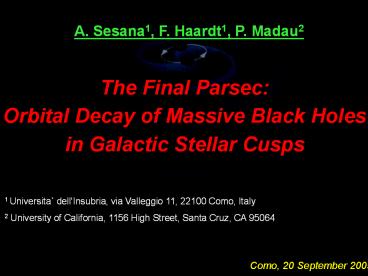Diapositiva 1 - PowerPoint PPT Presentation
Title:
Diapositiva 1
Description:
MBHB M1 M2 on a Keplerian orbit with semimajor axis a and eccentricity e ... K is typically positive, but the eccentricity evoution of. the binary is modest ... – PowerPoint PPT presentation
Number of Views:27
Avg rating:3.0/5.0
Title: Diapositiva 1
1
A. Sesana1, F. Haardt1, P. Madau2
The Final Parsec Orbital Decay of Massive Black
Holes in Galactic Stellar Cusps
1 Universita dell'Insubria, via Valleggio 11,
22100 Como, Italy 2 University of California,
1156 High Street, Santa Cruz, CA 95064
Como, 20 September 2005
2
OUTLINE gtMerging History of Massive Black
Holes gtMBHBs Dynamics the Final Parsec
Problem gtScattering Experiments Model
Description gtResults Binary Decay in a
Time-Evolvig Cuspy Background the Study
Case of the SIS gtEffects on
the Stellar Population
gtReturning Stars gtTidal Disruption
Rates gtImplication for
SMBH Coalescence gtSummary
3
MERGING HISTORY OF SMBHs
(Volonteri, Haardt Madau 2003)
Galaxy formation proceeds as a series of
subsequent halo mergers MBH assemby follow the
galaxy evolution starting from seed BHs with
mass 100M? forming in minihalos at z20
4
SMBHs DYNAMICS
5
DESCRIPTION OF THE PROBLEM
We want MBHBs to coalesce after a major merger
we need a physical mechanism able to shrink the
binary separation of about two orders of
magnitude!
6
GRAVITATIONAL SLINGSHOT
Extraction of binary binding energy via three
body interactions with stars
7
SCATTERING EXPERIMENTS
Z
gt MBHB M1gtM2 on a Keplerian orbit with
semimajor axis a
and eccentricity e gt incoming star with m ltltM2
and velocity v
gtThe initial condition is a point in a nine
dimensional parameter space gt qM2/M1, e,
m /M2 gt v, b, ?, ?, ?, ?
8
gt Tolerance is settled so that the energy
conservation for each orbit is of the order 10- 2
E gt Integration is stopped when
gt the star leave ri with positive total energy
gt the integration needs more than
106 steps gt the physical
integration time is gt1010 yrs gt
the star is tidally disrupted
9
M2/M11
M2/M11
e0
e0
C and B-C distributions vs. x, a rescaled impact
parameter defined as
10
SEMIANALITICAL MODEL
We consider gt a MBHB with a semimajor axis a
and eccentricity e gt a spherically simmetric
stellar background gt ?(r) ? 0(r/r0)-
? is the power law density profile.
(?0 is the density at the reference distance
r0 from the centre) gt f(v,?) is the
stellar velocity distribution. ? is
the 1- D velocity dispersion (in
the following we will always consider a
Maxwellian distribution)
11
C and B can be used to compute the MBHB evolution
12
F(bax,t) is a function, to be determined, of the
rescaled impact parameter x and of the time t and
depends on the density profile of the stellar
distribution Early studies (Mikkola Valtonen
1992, Quinlan 1996) assumed F(bax,t) 1 i.e. they
studied the hardening problem in a flat core of
density ?0 constant in time!!
1- Almost all galaxies show cuspy density
profiles in their inner regions
? ?r -? 0lt ? lt2.5
(n.b. faint early type galaxies show
steeper cusps that giants ellipticals)
2- In real galaxies there is a finite supply of
stars to the hardening process
13
1-HARDENING IN A CUSPY PROFILE
We consider a density profile
? ? r -?
14
Eccentricity Growth
15
2-MODELLING THE LOSS CONE CONTENT
16
THE SINGULAR ISOTHERMAL SPHERE (SIS)
gt we can factorize F(bax,t) ?F0 (bax) x ?(t)
gt The umperturbed loss cone mass content is Mlc
3/2 ? M 2
17
1- MBHB Shrinking
18
2-Distribution of Scattered Stars
19
(No Transcript)
20
(No Transcript)
21
3-The Role of Returning Stars
22
Final Velocity Distribution
23
4-Tidal Disruption Rates
A star is tidally disrupted if it approaches one
of the holes as close as the tidal disruption
radius rtd,i(m / Mi)1/3r
We can then derive the mean TD rate as N TD
stars / hardening time
gt The TD rate is extremely high during the
hardening phase (respect to TD rates due to
a single BH 10- 4 star/yr) gt The high TD rate
phase is extremely short
24
5-Binary Coalescence
25
e0
e0.6
e0.9
26
What can help ? gt MBHB random walk (e.g.
Quinlan Hernquist 1997, Chatterjee et al.
2003) gt Star diffusion in the loss cone via
two body relaxation (Milosavljevic Merritt
2001) gt Loss cone amplification (loss wedge) in
axisimmetric and triaxial potentials (Yu
2002, Merritt Poon 2004) gt Torques exerted on
the MBHB by a gaseous disk (Armitage
Natarajan 2002, Escala et al. 2005, Dotti et al.
in preparation)
27
Summary
gtWe have studied the interaction MBHB-stars in
detail using scattering experiments
coupled with a semianalitical model for
MBHB and steller background evolution including
gta cuspy time-evolving stellar
background gtthe effect of
returning stars
Results
gtH in the hard stage is proportional to a -?/2
gtK is typically positive, but the eccentricity
evoution of the binary is modest
gtMBHB-star interactions flatten the stellar
distribution
gtInteracting stars typically corotate with the
MBHB
gtA mass of the order of 0.7M is ejected from the
bulge on nearly radial corotating orbits in
the MBHB plane
gtLISA binaries may need the support of other
mechanisms to reach coalescence within an
Hubble time
28
Future Prospects
- Investigate the contribution of other
mechanisms to
the binary hardening - Evaluate the eventual role of bound stellar cusps
- Include this treatment of MBHB dynamics in a
merger tree model to give realistic estimations
for the number counts of LISA coalescences

